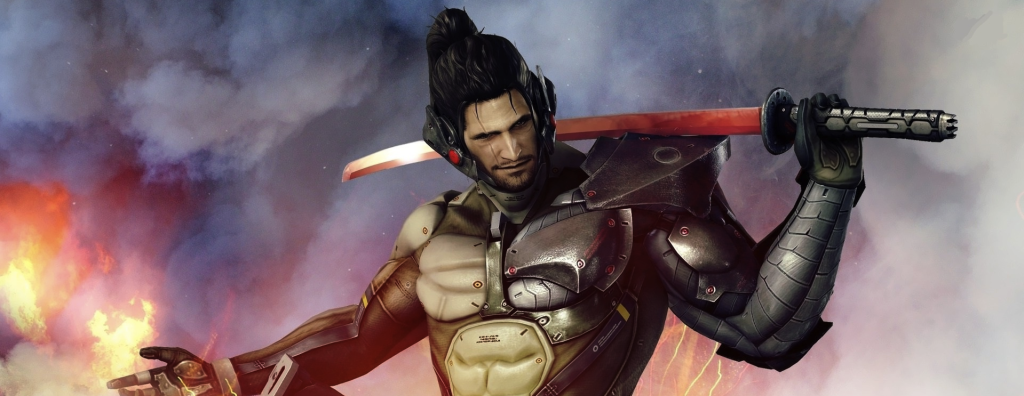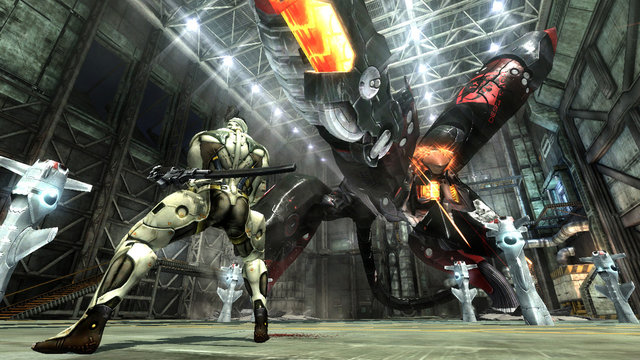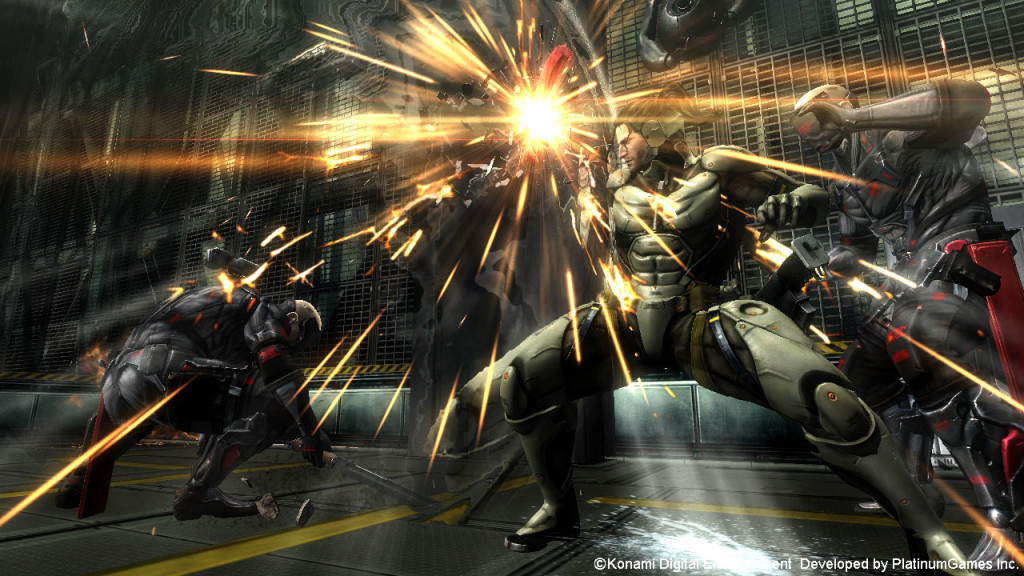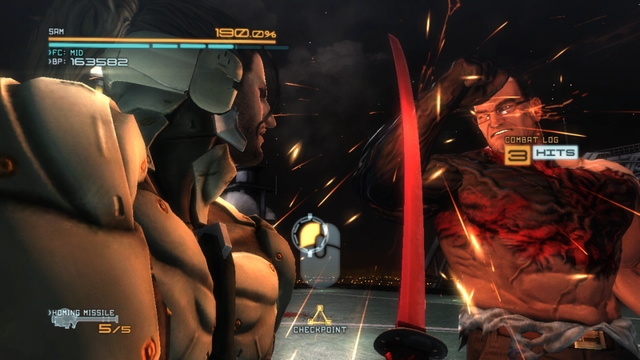
Given my love for Platinum Games, I’d be remiss not to actually review the DLC. Considering it’s now a part of the base game for nearly everyone who purchases it, it’s included. Think of this as an addendum to my original review (and the subsequent entry). Jetstream Sam and Blade Wolf are pretty much new stages altogether, with completely new mechanics, so it feels like a waste to ignore them on Theology Gaming. It’s also a nice excuse to talk about Metal Gear Rising: Revengeance some more, mostly its failures on the DLC front. But, you know, I’m a patient sort, as Paul would implore us.
Therefore I…implore you to walk in a manner worthy of the calling with which you have been called, 2 with all humility and gentleness, with patience, showing tolerance for one another in love, 3 being diligent to preserve the unity of the Spirit in the bond of peace.
Ephesians 4
Sometimes, even games we love tend to frustrate us, and nothing was moreso the case than when I bought MGR:R’s DLC for full price. Thank goodness most Platinum Games products don’t have this problem! I criticize what I love; so be it. Also, I’m going to be a lot harder on the Blade Wolf thing anyway!
Jetstream Sam’s content, for its part, consists of one ginormous level with an entirely new play style, five new VR Missions, and a step-up in difficulty. I played through on Normal and Hard so far, and I found it heinously tricky in spots, much more so then Raiden’s game. In fact, this product could exist as a standalone, as you do NOT get an upgrade screen, nor the ability to pick out sections to replay – it’s an all or nothing long-form linear level. To level up Sam’s health or energy, you must find them in the stage (usually hidden behind a platforming sequence somewhere) or complete VR missions Those VR Missions reflect the upgrade more than anything else, as they test your skills with an entirely new ability set to the ABSOLUTE limit. Most of them consist of enemy gauntlets where they send wave after wave of enemies after your character, and you’d be wise to play with Sam quite a lot before attempting them.

Trust me, it’ll take time to adjust to Sam once you’ve played as a tricked-out Raiden. Sam, for his part, plays like a more precise version of your main character. He’s faster at attacking, has an enormously good roll-dodge (seriously, crazy-good) and his parry requires more precision but does more damage. Well, that’s not quite right – the parry block comes out and stays out much longer, but the timing for a parry counter requires more precision. That simply requires an adjustment period to time your button presses more accurately.
Sam’s power comes from his charge ability – press and hold either attack button, and he’ll begin charging – release to unleash a special attack. You can perform this right in the midst of combos, and each one provides a different attack. Some even fling projectiles, something Raiden never had. His normal attacks barely do any damage overall without a charge, meaning that rapid combos aren’t a focus; you must charge at the right opening, and seize opportunities, not blindly flail around with your combos. That will just get you killed. Even with a fully upgraded Sam, you will never take down enemies as fast as Raiden if you play like Raiden. Think of it as an arbitrary set of restrictions placed on the player for the purpose of fun – or masochism, if you prefer.
However, one mechanic changes things up a bit: the taunt. Sam in his cocky way can taunt enemies in the midst of combat, putting them in a berzerker rage. They turn red, become extra fast, and start using extra attacks you’ve never seen in the main game at an astonishing rate. To balance this, Sam sudden becomes a powerhouse when enemies enrage, and his charge attack will slice through normal enemies (not bosses, as you might suspect) in one blow. Thus, we could call Sam a “glass cannon” – a powerful weapon in the right hands, but one that can easily break if you make mistakes.

For the casual player, it makes no sense to take up the mantle of Jetstream Sam. For those into the mechanics, however, there’s a rigorous challenge here to be savored. Sam’s play style requires lots of good timing and figuring out the best time to release charge attacks. He has an air-dash and the ability to charge air attacks (which functions as a great jumping dash – HINT HINT) and you’ll find yourself using this quite often. His increased air movement capabilities will save you more than you think. Ninja run still reflects bullets, but his run does not automatically traverse obstacles; Sam gets a double jump instead, which becomes incredibly useful. Basically he gets increased mobility options and speed at the expense of health and attack power. It’s fair trade, but definitely one requiring some massive adjustments to your play. As Sam actually didn’t have many cybernetic implants at all, this makes perfect sense from a story perspective.
As far as other elements go, the enemy configurations frequently place you in close quarters combat – an unfortunate choice. The camera in MGR:R remains a problem here, except making mistakes with Sam feels much worse than doing the same with Raiden. He’s simply not as durable, and missing a parry due to a swing of the camera doesn’t do my patience any favors. Furthermore, the DLC does not introduce anything fundamentally new – Sam’s still a swordsmen, so it looks pretty similar overall, but it re-uses stages and designs from Chapter 4 (and 2, a little bit) pretty liberally, if not literally. Then again if you know anything about this game a simple re-use of stage design shouldn’t concern you so much as the camera issue.
This camera crops up especially in every one of the boss fights: one against LQ-84i (or maybe a model of it), one against Metal Gear Ray, and one against Senator Armstrong. They’re not all re-dos of the previous; the attack patterns were modified heavily, and it seems they all follow the old “boss fight” adage of making a boss quicker, faster, harder to predict, and stronger as they lose health. HOWEVER, and here’s the problem, they all take place in tiny areas NOT suited for the boss patterns. To take a quick example: The LQ-84i fight takes place in a narrow sewer, whereas the original took place in a wide open area; same goes for the Ray fight, which now takes place in a tiny hangar. It makes the camera swing around for no reason while the boss attacks you relentlessly – clearly, not a recipe for success.

However, it’s the Armstrong fight that put me in a rage, and not for a good reason. Armstrong’s a reasonably difficult fight in the normal game, but you can learn his pattern rather easily if you put any effort into it (even on higher difficulties). Not so much here – you fight Armstrong on the same platform on which you fight Sundowner – if this sounds like a good idea with all of Armstrong’s charging attacks, you are completely and utterly wrong. When Armstrong dashes to the “edge” of the helicopter platform, the invisible wall doesn’t makes him stop. Instead, he dashes back towards you as the camera swings around – don’t be surprised if you get hit repeatedly, and not even by your own reckoning. It certain did NOT help that my controller started malfunctioning during the fight or that Jetstream Sam actually stops after certain charge attacks, because both of those get you killed. Again, I attribute part of this to unfamiliarity with the character, but it felt incredibly frustrating.
Worse, Armstrong’s new and incredibly dumb fire charge (think Bison’s Psycho Crusher) makes the camera issues all the more apparent and jarring. If he comes close to the edge of the arena, he’ll turn IMMEDIATELY around and charge towards you. At the same time, the camera will swoop around to catch up with Armstrong; by the time you know what happened, Armstrong rocked your face. Armstrong also starts doing these attacks incessantly at the end, to the point where you need some perfect reflexes to get hits – it’s a shame, really, that the fight’s so buggy rather than challenging. It’d be really fun without the camera issues, but now it’s a complete memorization fest at higher levels, and not by design. I remember the Armstrong fight so vividly that it nearly spoiled the rest, honestly!
Still, if you’re willing to put up with niggling design flaws that already existed in the base game, and you play for the challenge and fun of learning a new character, then this one’s definitely worth your ten dollars. As far as the rest of the audience, though, I’d recommend against it. This isn’t a “one playthrough” DLC, and it wasn’t designed that way. MGR:R works around designing enemy encounters in nondescript rooms – in other words, action-based puzzles solved in real-time and on the fly. Jetstream Sam’s DLC adds a little more of that enjoyment to the main game, and if you didn’t find it engaging the first time, you won’t now either.
Hey, if you could actually rent it, I’d tell you to do it, but I guess you’ll need to buy it. Thankfully, it’s included in the PC version, so I’d direct you towards that!
